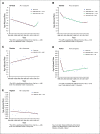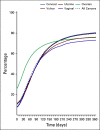Panorama of Gynecologic Cancer in Brazil
- PMID: 33108231
- PMCID: PMC7605369
- DOI: 10.1200/GO.20.00099
Panorama of Gynecologic Cancer in Brazil
Abstract
Purpose: Little is known, or has been published previously, regarding consolidated data on the epidemiology of gynecologic cancers (GC) in Brazil. This article describes the incidence, morbidity, and mortality of women in Brazil affected with GC between the years of 2000 and 2017.
Methods: Incidence, morbidity, and mortality data from patients with a diagnosis of one out of the five most common GC, cervical (CC), uterine (UC), ovarian (OC), vulvar (VvC), and vaginal (VgC), were obtained from three governmental sources of data.
Results: From 2000 to 2015 CC, OC, and VgC incidence rates (IRs) decreased, whereas the IRs for UC and VvC remained relatively stable. Data from 382,932 women with GC were analyzed. Most patients presented with locally advanced or advanced disease at diagnosis: 60.1% of patients with CC, 31.2% of patients with UC, 67.2% of patients with OC, 45.2% of patients with VvC, and 67.0% of patients with VgC. Time from diagnosis to first treatment was ≥ 60 days in 58.0% of patients with CC, 58.5% of patients with UC, 27.0% of patients with OC, 55.3% of patients with VvC, and 52.7% of patients with VgC. Regarding mortality rates (MRs), with the exception of CC, UC, and VvC, which showed a slight decrease, MRs remained stable between 2000 and 2017.
Conclusion: A comparison with international data indicates that Brazilian patients are diagnosed with more advanced disease and face a longer delay between diagnosis and first treatment. Despite advances in screening and treatment, GC mortality has not decreased satisfactorily in this country.
Conflict of interest statement
Eduardo Paulino
Andreia Cristina de Melo
Angelica Nogueira-Rodrigues
No other potential conflicts of interest were reported.
Figures



References
-
- American Cancer Society: Cancer Facts & Figures 2018. Atlanta, GA: American Cancer Society, 2018.
-
- Instituto Nacional de Câncer Estatísticas de câncer [in Portugese] https://www.inca.gov.br/numeros-de-cancer
-
- Atlas do Desenvolvimento Humano no Brasil [in Portugese]. http://atlasbrasil.org.br/2013/
-
- Instituto Nacional de Câncer https://www.inca.gov.br/
-
- Instituto Brasileiro de Geografia e Estatistica https://www.ibge.gov.br/
MeSH terms
LinkOut - more resources
Full Text Sources
Miscellaneous

